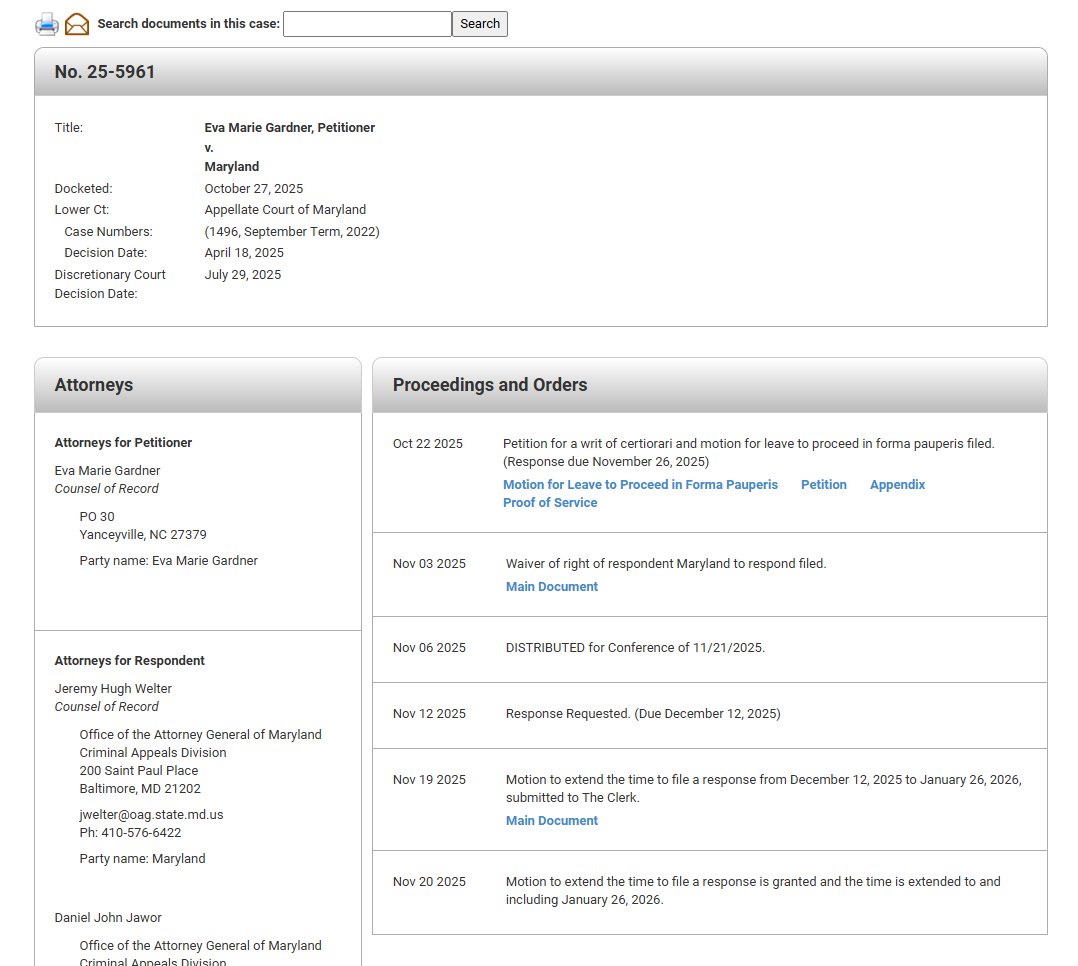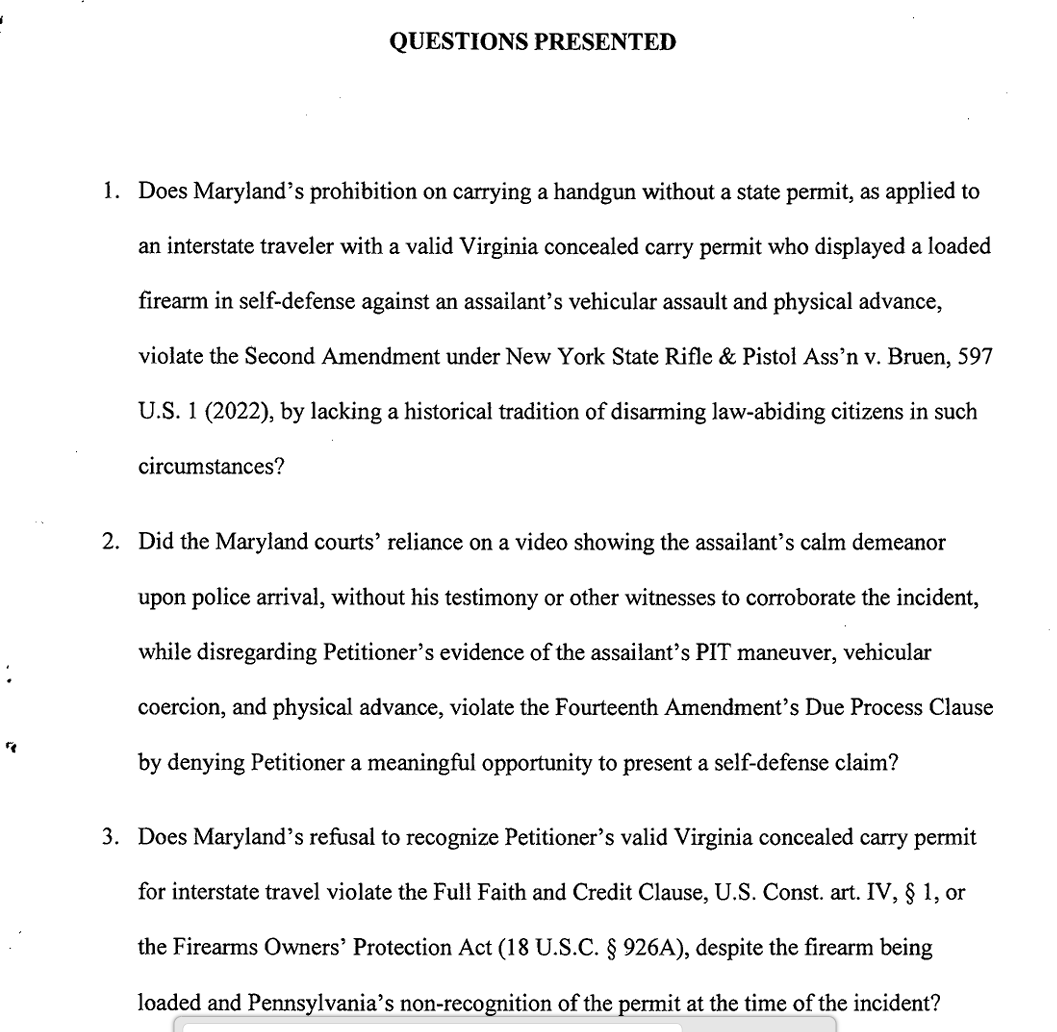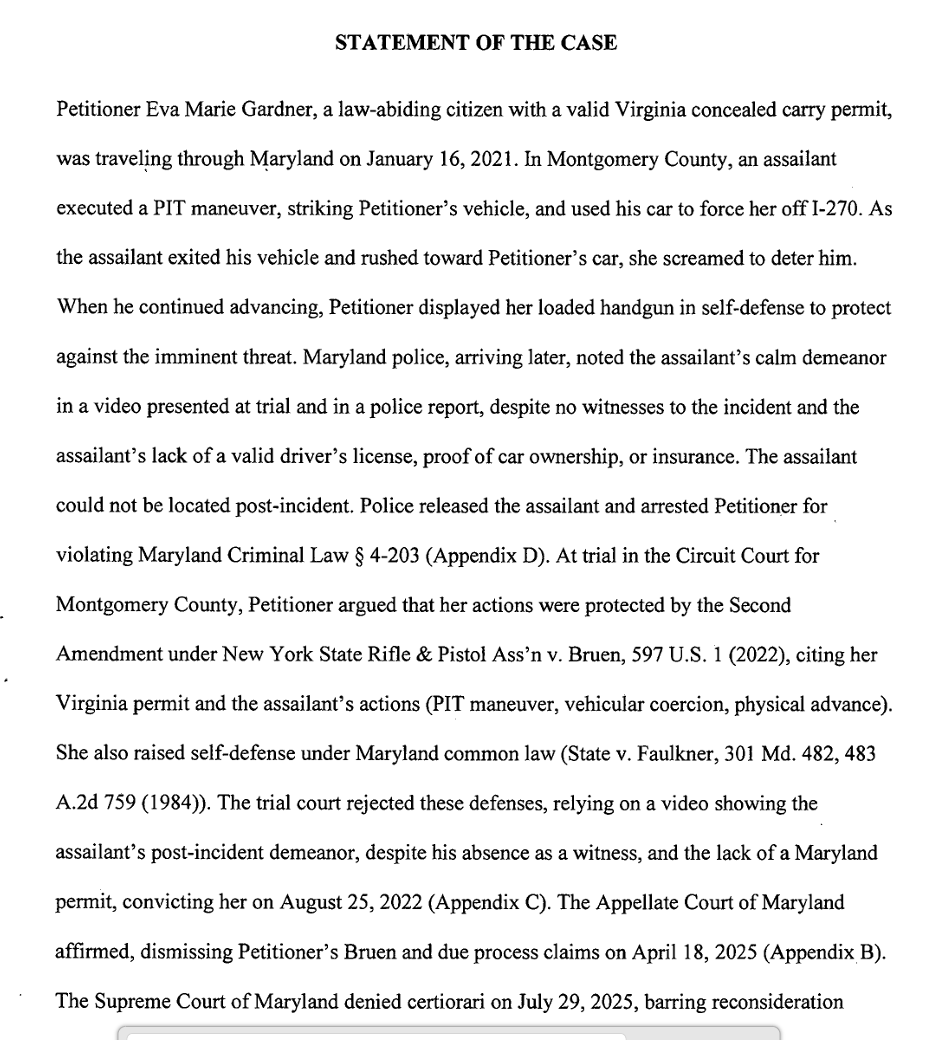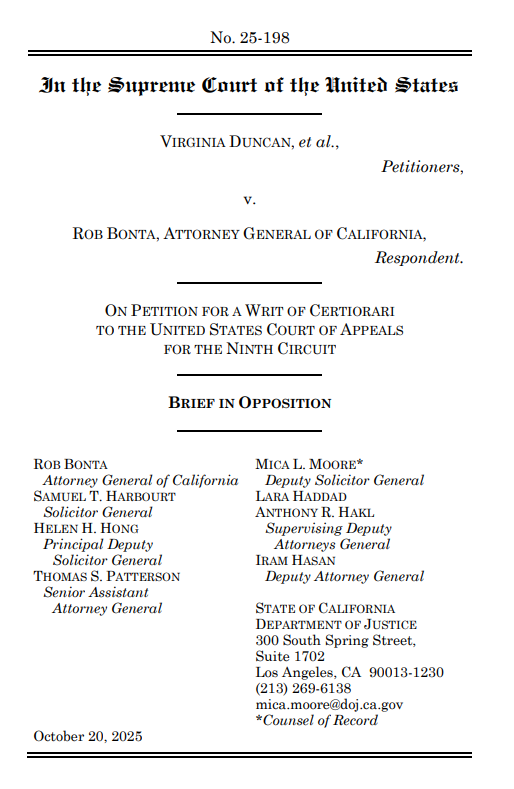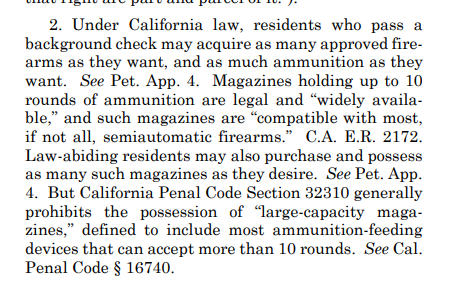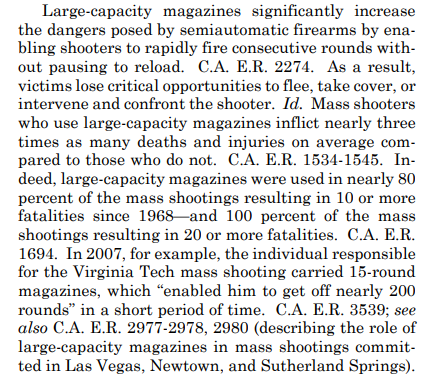My Rahimi live thread here. The basic holding is, as Chuck notes, "When an individual has been found by a court to pose a credible threat to the physical safety of another, that individual may be temporarily disarmed consistent with the Second Amendment."
8-1 case.
ROBERTS, C. J., delivered the opinion for the Court, in which ALITO, SOTOMAYOR, KAGAN, GORSUCH, KAVANAUGH, BARRETT, and JACKSON, JJ., joined. SOTOMAYOR, J., filed a concurring opinion, in which KAGAN, J., joined. GORSUCH, J., KAVANAUGH, J., BARRETT, J., and JACKSON, J., filed concurring opinions. THOMAS, J., filed a dissenting opinion.
Getting my toddler breakfast, then we begin 🤣
8-1 case.
ROBERTS, C. J., delivered the opinion for the Court, in which ALITO, SOTOMAYOR, KAGAN, GORSUCH, KAVANAUGH, BARRETT, and JACKSON, JJ., joined. SOTOMAYOR, J., filed a concurring opinion, in which KAGAN, J., joined. GORSUCH, J., KAVANAUGH, J., BARRETT, J., and JACKSON, J., filed concurring opinions. THOMAS, J., filed a dissenting opinion.
Getting my toddler breakfast, then we begin 🤣
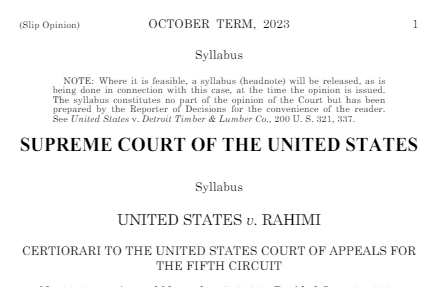
First bit of good news comes at the start of the analysis. This language would seem to call into question laws that disarm AFTER a restraining order has ended. California bans people who had a restraining order from carrying for five years. 

I don't disagree with this, as it is what Bruen said too. But man, we are going to hear "not meant to suggest a law trapped in amber" a lot from the antigun courts. 

They don't decide subsection (ii), which is annoying because that is the clearly unconstitutional one as it does not require a finding of dangerousness. 

A common dumb talking point that arose with Rahimi was "it's terrible that we have to be bound by 18th century values, as wife beating was legal then!"
Sure, domestic abuse was too tolerated then, but as @AnnaBarvirBoone discussed in her amicus brief on behalf of CRPA, that had already begun to change. The Court touches on that here.
Sure, domestic abuse was too tolerated then, but as @AnnaBarvirBoone discussed in her amicus brief on behalf of CRPA, that had already begun to change. The Court touches on that here.

I agree that this has some reasonable degree of similarity to the challenged law, though there are differences.
I suspect lower courts are going to be using this example of a moderately similar law to rubberstamp completely dissimilar laws though.
I suspect lower courts are going to be using this example of a moderately similar law to rubberstamp completely dissimilar laws though.

I'm less sold on Roberts' use of the going armed laws. Yes, those apply to dangerousness generally I suppose, but the link is more tenuous than the surety laws. 

This is a confusing paragraph. At first they seem to give legislatures leeway on "categories of persons thought by a legislature to present a special danger of misuse", but then they say the law survives because it requires a finding of dangerousness.
It looks like they need to decide Range then to start determining the extent of the legislatures' ability to ban certain categories of persons from possession?
It looks like they need to decide Range then to start determining the extent of the legislatures' ability to ban certain categories of persons from possession?

I like this portion a lot, and it will help challenge some of California's abuses with CCW permitting, including one of our arguments in CRPA vs. LASD. 

Another great bit. This is an argument governments have pushed a lot, especially in denying CCW permits. 

Getting the "temporarily" bit in there, especially in a Roberts opinion, is a W I'll take.
But man, sure would be nice if they decided stuff a little faster.
But man, sure would be nice if they decided stuff a little faster.

The Opinion of the Court by Roberts is quite short at 18 pages.
But then there are around 80 pages of concurring opinions plus Thomas's dissent. As these are not controlling, I will move through them a bit faster so this thread doesn't eat my whole day.
But then there are around 80 pages of concurring opinions plus Thomas's dissent. As these are not controlling, I will move through them a bit faster so this thread doesn't eat my whole day.
Sotomayor starts by saying she disagrees with Bruen still, but her opinion reads like she is mostly fine with it so long as Thomas's strict application of it is not controlling.




Interestingly, Sotomayor does not seem to suggest that Heller's core holding that the Second Amendment is an individual right was wrong. She implicitly recognizes that the overton window has shifted I think. Even this concurrence seems to accept the premise of the individual right as a starting point.

I thank Justice Sotomayor for at least having a short concurrence, which apparently, is an achievement given how long some of these others appear to be.
Concurrences that drone on and on when they are not controlling irritate me. It's fine for a dissent.
Concurrences that drone on and on when they are not controlling irritate me. It's fine for a dissent.
Some people are already reacting to Rahimi as destroying the "how" part of the analysis in Bruen.
I disagree, and this from Gorsuch shows why.
That's not to say I am thrilled with some of the loosening present in the majority opinion, but commentary is already getting way too doomer-y.
I disagree, and this from Gorsuch shows why.
That's not to say I am thrilled with some of the loosening present in the majority opinion, but commentary is already getting way too doomer-y.

This paragraph about what they are not deciding wouldn't be as frustrating if they weren't so stingy with cert grants.
Start deciding those things, guys!
Start deciding those things, guys!

Next up is Kavanaugh.
You know guys it's really fine for not all of you to write an opinion.🤣
You know guys it's really fine for not all of you to write an opinion.🤣
As @StephenGutowski points out, a lot of the Kavanaugh concurrence seems to be originalism 101. For the purposes of this thread, I'm going to skip through it.
@StephenGutowski Will include this bit about bashing tiered scrutiny, because tiered scrutiny sucks. Thanks Kav. 

Kavanaugh says Second Amendment jurisprudence is still in its "early innings".
We're gonna need a faster pace of cert grants if we're ever going to get to later innings in our lifetimes guys.
We're gonna need a faster pace of cert grants if we're ever going to get to later innings in our lifetimes guys.

As much as any 2A opinion that makes @JacobDCharles happy annoys me 🤣, Barrett is correct that originalism is not, and never was a "use it or lose it" pact. Particularly with new problems not present then, which is when Bruen's "more nuanced approach" applies.
However, I think it continues to be true, as Bruen says, that if a particular problem DID exist in the past, and it was solved through very different means, then the challenged modern law is not supported by historical tradition. Legislatures may not have maximally exercised their power, but if they exercised their power in different ways when the modern "solution" would have been an obvious possibility to them, it probably means they saw that solution as unconstitutional.
To use the most extreme example to illustrate the point, violence with firearms and other weapons was a societal problem back then too. But they didn't ban guns for everyone, which would be an obvious (and obviously unconstitutional) solution. Instead, they disarmed dangerous people.
However, I think it continues to be true, as Bruen says, that if a particular problem DID exist in the past, and it was solved through very different means, then the challenged modern law is not supported by historical tradition. Legislatures may not have maximally exercised their power, but if they exercised their power in different ways when the modern "solution" would have been an obvious possibility to them, it probably means they saw that solution as unconstitutional.
To use the most extreme example to illustrate the point, violence with firearms and other weapons was a societal problem back then too. But they didn't ban guns for everyone, which would be an obvious (and obviously unconstitutional) solution. Instead, they disarmed dangerous people.

It'd be nice if when they warned against watering down the right as Barrett does here, they gave some examples. Otherwise, their warning has no meaning. 

Justice Jackson unsurprisingly wants to overturn Bruen. Most of the "struggles" of lower courts are due to their bad faith. They insist completely dissimilar laws are analogous. 

Jackson also argues Heller was wrong, calling it a "newly unearthed right".
Complete nonsense. As I and others have shown, the historical evidence showing the Second Amendment is an individual right is overwhelming. The US government even cited some of it in its briefing.
And when you back all sorts of "rights" that have no basis in our history, as Jackson does, sneering about "unearthed" new rights is probably not a great call.
Complete nonsense. As I and others have shown, the historical evidence showing the Second Amendment is an individual right is overwhelming. The US government even cited some of it in its briefing.
And when you back all sorts of "rights" that have no basis in our history, as Jackson does, sneering about "unearthed" new rights is probably not a great call.

It really isn't a difficult task. The job of judges often involves comparing one law to another, or one precedent to a new situation. This is basic legal analysis, especially given that the government is the one presenting the history, courts need not research it themselves (though many have taken to doing so).

Thomas's dissent agrees there is some similarity, but contends that the "how" in the surety laws is different. He's not wrong about that. The Court has loosened that aspect of Bruen. 

I agree with a lot of Thomas's discussion of the clearly dissimilar "analogues" the government claimed, but given the majority did not rely on them, I don't think they mattered anyway. 

It's probably fair to say Thomas does seem to be reaching a bit for a "dead ringer" here. He wrote in Bruen that the analogical standard does not require a perfect fit. I'd like to see more discussion on where the line is, because if he is insisting on only near-identical laws, it's not surprising no one joined this dissent.
That's not to say he doesn't have a point about the very different burdens imposed by the surety laws compared to the modern law, and the majority should have addressed that head on.
That's not to say he doesn't have a point about the very different burdens imposed by the surety laws compared to the modern law, and the majority should have addressed that head on.

This is indeed the most troubling part of the majority opinion. It will be greatly abused if the Court does not grant cert soon on other important questions. 

Thomas notes he does agree with the majority that Government may not disarm people simply for being "irresponsible". 

Requiring specific historical regulations is indeed a win. We dealt with governments citing vague principles and even modern scholarly commentary talking about history. 

Well, that was a lot! In a bit I will have my overall takeaways. First, I will read the short majority opinion one more time.
• • •
Missing some Tweet in this thread? You can try to
force a refresh













